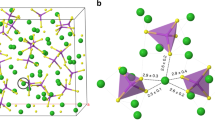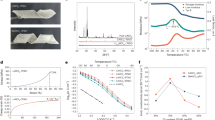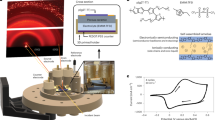Abstract
Solid electrolytes are a class of materials in which the cationic or anionic constituents are not confined to specific lattice sites, but are essentially free to move throughout the structure. The solid electrolytes AgI and Ag2Se (refs 1, 2, 3, 4, 5, 6, 7) are of interest for their use as additives in network glasses8,9,10,11,12, such as chalcogenides and oxides, because the resulting composite glasses can show high electrical conductivities with potential applications for batteries, sensors and displays. Here we show that these composite glasses can exhibit two distinct types of molecular structures—an intrinsic phase-separation that results in a bimodal distribution of glass transition temperatures, and a microscopically homogeneous network displaying a single glass transition temperature. For the first case, the two transition temperatures correspond to the solid-electrolyte glass phase and the main glass phase (the ‘base glass’), enabling us to show that the glass transition temperatures for the AgI and Ag2Se phases are respectively 75 and 230 °C. Furthermore, we show that the magnitude of the bimodal glass transition temperatures can be quantitatively understood in terms of network connectivity, provided that the Ag+ cations undergo fast-ion motion in the glasses. These results allow us to unambiguously distinguish base glasses in which these additives are homogeneously alloyed from those in which an intrinsic phase separation occurs, and to provide clues to understanding ion-transport behaviour in these superionic conductors.
This is a preview of subscription content, access via your institution
Access options
Subscribe to this journal
Receive 51 print issues and online access
$199.00 per year
only $3.90 per issue
Buy this article
- Purchase on Springer Link
- Instant access to full article PDF
Prices may be subject to local taxes which are calculated during checkout




Similar content being viewed by others
References
Tubandt, C. & Lorenz, E. Molekularzustand und elektrisches Leitvermögen kristallisierter Salze. Z. Phys. Chem. 24, 513–543 (1914).
Bradley, J. N. & Greene, P. D. Solids with high ionic conductivity in group I halide system. Trans. Faraday Soc. 63, 424–430 (1967).
Minami, T., Imazawa, K. & Tanaka, M. Formation region and characterization of superionic conductivity glasses in the systems AgI-Ag2O-MxO7. J. Non-Cryst. Solids 42, 469–476 (1980).
Rousselot, C. et al. The origins of neutron scattering prepeaks and conductivity enhancement in AgI-containing glasses. Solid State Ionics 78, 211–221 (1995).
Kincs, J. & Martin, S. W. Non-Arrhenius conductivity in glasses: mobility and conductivity saturation effects. Phys. Rev. Lett. 76, 70–73 (1996).
Swenson, J., McGreevy, R. L., Börjesson, L., Wicks, J. D. & Howells, W. S. Intermediate-range structure of fast-ion-conductivity. J. Phys. Condens. Matter 8, 3545–3552 (1996).
Angell, C. A. Mobile ions in amorphous solids. Annu. Rev. Phys. Chem. 43, 693–717 (1992).
Boolchand, P. & Bresser, W. J. The structural origin of broken chemical order in GeSe2 glass. Phil. Mag. B 80, 1757–1772 (2000).
Phillips, J. C. Topology of covalent non-crystalline solids I: short range order in chalcogenide alloys. J. Non-Cryst. Solids 34, 153–181 (1979).
Mitkova, M., Wang, Y. & Boolchand, P. Dual chemical role of Ag as an additive in chalcogenide glasses. Phys. Rev. Lett. 83, 3848–3851 (1999).
Feng, X., Bresser, W. J. & Boolchand, P. Direct evidence for stiffness threshold in chalcogenide glasses. Phys. Rev. Lett. 78, 4422–4425 (1997).
Georgiev, D. G., Boolchand, P. & Micoulaut, M. Rigidity transitions and molecular structure of AsxSe1-x glasses. Phys. Rev. B 62, R9228–R9232 (2000).
Slivka, V. Y., Vysochanskii, Y. M., Stefanovich, V. A., Gerasimenko, V. S. & Chepur, D. V. Features of the vibrational spectra of AgAsS2. Sov. Phys. Solid State 24, 392–398 (1982).
Kerner, R. & Micoulaut, M. On the glass transition temperature in covalent glasses. J. Non-Cryst. Solids 210, 298–305 (1997).
Micoulaut, M. The slope equations: a universal relationship between local structure and glass transition temperature. Eur. Phys. J. B 1, 277–294 (1998).
Zhang, M. & Boolchand, P. The central role of broken bond-bending constraints in promoting glass formation in the oxides. Science 266, 1355–1357 (1994).
Barnes, A. C., Lague, B. S., Salmon, S. P. & Fischer, H. E. A determination of the structure of liquid Ag2Se using neutron diffraction and isotopic substitution. J. Phys. Condens. Matter. 9, 6159–6173 (1997).
Phillips, J. C. Bonds and Bands in Semiconductors 45 (Academic, New York, 1973).
Nield, V. M., Keen, D. A., Hayes, W. & McGreevy, R. L. Structure and fast-ion conduction in α-AgI. Solid State Ionics 66, 247–258 (1993).
Thorpe, M. F., Jacobs, D. J., Chubynsky, M. V. & Phillips, J. C. Self-organization in network glasses. J. Non-Cryst. Solids 266–269, 859–866 (2000).
Cramer, C., Price, D. L. & Saboungi, M. L. Structure of AgI/Ag2SeO4 fast-ion conducting glasses: neutron diffraction experiments. J. Phys. Condens. Matter. 10, 6229–6242 (1998).
Shastry, M. C. R. & Rao, K. J. Physico-chemical investigation of fast ion conducting AgI-Ag2SeO4 glasses. Proc. Ind. Acad. Sci. 102, 541–553 (1990).
Zallen, R. The Physics of Amorphous Solids 190 (Wiley & Sons, New York, 1998).
Bunde, A., Funke, K. & Ingram, M. D. Ionic glasses: History and challenges. Solid State Ionics 105, 1–13 (1998).
Swenson, J. & Börjesson, L. Correlation between free volume and ionic conductivity in fast ion conducting glasses. Phys. Rev. Lett 7, 3569–3572 (1996).
Roling, B., Happe, A., Funke, K. & Ingram, M. D. Carrier concentrations and relaxation spectroscopy: new information from scaling properties of conductivity spectra in ionically conducting glasses. Phys. Rev. Lett. 78, 2160–2163 (1997).
Acknowledgements
We thank D.H. McDaniel, M. Mitkova, D. Georgiev, B. Goodman and M. Micoulaut for discussions. This work was supported by the Solid State Physics Program of the National Science Foundation.
Author information
Authors and Affiliations
Corresponding author
Supplementary information

Figure 1a
(GIF 12.7 KB)

Figure 1b
(GIF 11.0 KB)
Figure shows MDSC scans of (a) (AgI) x(Ge0.22Se0.78)1-x glasses and (b) (Ag2Se)x(GeSe4)1-x glasses at indicated molar content x of respective electrolyte additives. In panel (a), one observes the AgI glass Tg endotherm fraction near 75°C and the transition endotherm fraction near 150°C (indicated by an asterisk) to progressively increase with x. In panel (b), one observes the Ag2Se glass Tg endotherm fraction near 230°C to monotonically increase with x. These results support the suggested Tg assignments made for respective solid-electrolyte glasses.
Rights and permissions
About this article
Cite this article
Boolchand, P., Bresser, W. Mobile silver ions and glass formation in solid electrolytes. Nature 410, 1070–1073 (2001). https://doi.org/10.1038/35074049
Received:
Accepted:
Issue Date:
DOI: https://doi.org/10.1038/35074049
This article is cited by
-
Unconventionally anisotropic growth of PbSe nanorods: Controllable fabrication under solution-solid-solid regime over Ag2Se catalysis for broadband photodetection
Nano Research (2021)
-
Study of ac conductivity mechanism and impedance spectroscopy in CNT-added Cu5Se75Te10In10 chalcogenide system
Bulletin of Materials Science (2020)
-
Effect of carbon nanotube additive on the structural and thermal properties of Se85Te10Ag5 glassy alloy
Journal of Thermal Analysis and Calorimetry (2015)
-
A Simple and Facile Iodination Method for Improving Sinterability and Electrical Conductivity of Silver Thick Films
Journal of Electronic Materials (2014)
-
Synthesis and Characterization of Silver Selenide Nanoparticles via a Facile Sonochemical Route Starting from a Novel Inorganic Precursor
Journal of Inorganic and Organometallic Polymers and Materials (2013)
Comments
By submitting a comment you agree to abide by our Terms and Community Guidelines. If you find something abusive or that does not comply with our terms or guidelines please flag it as inappropriate.



